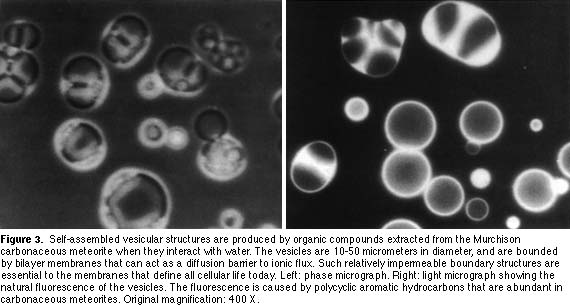Did Life Evolve in Ice?Funky properties of frozen water may have made life possible.
[...]
But strange things happen when you freeze chemicals in ice. Some reactions slow down, but others actually speed up—especially reactions that involve joining small molecules into larger ones. This seeming paradox is caused by a process called eutectic freezing. As an ice crystal forms, it stays pure: Only molecules of water join the growing crystal, while impurities like salt or cyanide are excluded. These impurities become crowded in microscopic pockets of liquid within the ice, and this crowding causes the molecules to collide more often. Chemically speaking, it transforms a tepid seventh-grade school dance into a raging molecular mosh pit.
[...]
“The strong point of freezing,” according to Orgel, “is that you concentrate things very efficiently without evaporation.” Freezing also helps preserve fragile molecules like nucleobases, extending their lifetime from days to centuries and giving them time to accumulate and perhaps organize into something more interesting—like life.
[...]
By the time Trinks returned to Hamburg in 2003, he had formulated a theory that ice was doing much more than just concentrating chemicals. The ice surface is a checkerboard of positive and negative charges; he imagined those charges grabbing individual nucleobases and stacking them like Pringles in a can, helping them coalesce into a chain of RNA. “The surface layer between ice and liquid is very complicated,” he says. “There is strong bonding between the surface of the ice and the liquid. Those bondings are important for producing long organic chains like RNA.”
[...]
For decades researchers had tried to coax RNA chains to form under all sorts of conditions without using enzymes; the longest chain formed, which Orgel accomplished in 1982, consisted of about 40 nucleobases. So when Biebricher analyzed his own samples, he was amazed to see RNA molecules up to 400 bases long. In newer, unpublished experiments he says he has observed RNA molecules 700 bases long. Biebricher’s results are so fantastic that some colleagues have wondered whether accidental contamination played a role. Orgel defended the work. “It’s a remarkable result,” he said. “It’s so remarkable that everyone wants better evidence than they would for an unremarkable result. But I think it’s right.”
Biebricher had loaded the deck somewhat, because he wasn’t growing RNA chains from nothing. Before he froze his samples, he added an RNA template—a single-strand chain of RNA that guides the formation of a new strand of RNA. As that new RNA strand grows, it adheres to the template like one half of a zipper to the other. This must be how the first genes, made of RNA, would have copied themselves. But the first step was the formation of the original RNA molecule that served as a template, and how that step happened remains a mystery.
Ice may prove the crucial ingredient here, too. Deamer and his former student Pierre-Alain Monnard (now at Los Alamos National Laboratory in New Mexico) have run experiments frozen at 0°F for a month, without the aid of templates. In those relatively brief experiments they already see RNA molecules up to 30 bases long, at least as long as other researchers have seen in similar experiments without ice.
[...]
How do you get from tiny snippets of RNA to longer, well-crafted chains that could have acted as the first enzymes, doing fancy things like copying themselves The shortest RNA enzyme chains known today are about 50 bases long; most have more than 100. To work effectively, moreover, an RNA enzyme must fold correctly, which requires exactly the right sequence of bases.
A young scientist named Alexander Vlassov stumbled upon a possible answer. He was working at SomaGenics, a biotech company in Santa Cruz, California, to develop RNA enzymes that latch on to the hepatitis C virus. His RNA enzymes were behaving strangely: They normally consisted of a single segment of RNA, but every time he cooled them below freezing to purify them, the chain of RNA spontaneously joined its ends into a circle, like a snake biting its tail. As Vlassov worked to fix the technical glitch, he noticed that another RNA enzyme, called hairpin, also acted strangely. At room temperature, hairpin acts like scissors, snipping other RNA molecules into pieces. But when Vlassov froze it, it ran in reverse: It glued other RNA chains together end to end.
Vlassov and his coworkers, Sergei Kazakov and Brian Johnston, realized that the ice was driving both enzymes to work in reverse. Normally when an enzyme cuts an RNA chain in two, a water molecule is consumed in the process, and when two RNA chains are joined, a water molecule is expelled. By removing most of the liquid water, the ice creates conditions that allow the RNA enzyme to work in just one direction, joining RNA chains.
[...]
The SomaGenics scientists wondered whether an icy spot on early Earth could have driven a primitive enzyme to do the same. To investigate this, they introduced random mutations into the hairpin RNA, shortened it from its normal length of
58 bases, and even cut it into pieces—all in an effort to produce RNA enzymes that were as dodgy and imperfect as early Earth’s first enzymes likely were. These pseudoprimitive RNA enzymes do nothing at room temperature. But freeze them and they become active, joining other RNA molecules at a slow but measurable rate.
[...]
http://discovermagazine.com/2008/feb/di ... ve-in-ice/Ainda relacionado:
Cold Sugar in Space Provides Clue to the Molecular Origin of Lifehttp://www.spaceref.com/news/viewpr.html?pid=15078The Tree of Life: Cold Start?http://www.astrobio.net/news/article302.html
